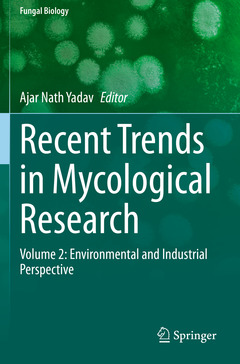Preface
Chapter 1: Mycological Research for Environmental and Industrial Significances: An Introduction
Dr. Ajar Nath Yadav Department of Biotechnology, Eternal University Baru Sahib, Srmour-173101, Himachal Pradesh, India
Chapter 2: Fungal Communities For Bioremediation of Contaminates Soil for Sustainable Environment
Dr. B. Bharathiraja, Department of Chemical Engineering, Vel Tech High Tech Dr. Rangarajan Dr. Sakunthala Engineering College, Avadi, Chennai-600062. India
Chapter 3: White-rot Fungi for Bioremediation of Polychlorinated Biphenyl Contaminated Soil
Dr. Tomáš Cajthaml, Institute of Microbiology, Academy of Sciences of the Czech Republic v.v.i., Vídeňská 1083, CZ-142 20, Prague 4, Czechia
Chapter 4: Fungi in Remediation of Hazardous Wastes: Current Status and Future Outlook
Dr. Indu Shekhar Thakur, School of Environmental Sciences, Jawaharlal Nehru University, New Delhi, India
Chapter 5: Fungi and their Secondary Metabolites for Bioremediation of Hazardous Heavy Metals
Prof. Dr. Eduardo Sydney, Federal University of Technology - Paraná/Brazil (UTFPR), Curitiba, Brazil
Chapter 6: Fungal Enzymes: Degradation and Detoxification of Organic and Inorganic Pollutants
Dr. Ram Naresh Bharagava, Department of Microbiology, Babasaheb Bhimrao Ambedkar University, Lucknow, India
Chapter 7: Applications of Nanotechnology in Mycoremediation: Current Status and Future Challenges
Dr. Salma Mukhtar, Department of Biological Sciences, Forman Christian, Lahore, Pakistan
Chapter 8: Fungal Communities and their Extracellular Hydrolytic Enzymes for Biodegradation of N-Containing Xenobiotics
Dr. Owen P. Ward, Department of Biology, University of Waterloo, Waterloo, Canada
Chapter 9: Industrially Important Bioactive Compounds and Secondary Metabolites from Fungal Communities
Dr. Barbara Schulz, Institute of Microbiology, Technical University of Braunschweig, Spielmannstrasse 7, D-38106 Braunschweig, Germany
Chapter 10: Marine Fungal Communities: Metabolic Engineering for Secondary metabolites and their Industrial Applications
Dr. Lennart Richter, Institute of Chemistry, Department of Biological Chemistry, Berlin University of Technology, Berlin, Germany
Chapter 11: Hydrolytic Enzymes Producing Fungal Communities and their Industrial Applications for Sustainable Developments
Dr. Selvaraju Sivamani, Chemical Engineering Section, Engineering Department, Salalah College of Technology, Salalah, Oman
Chapter 12: Bioprospecting of Endophytic and Rhizospheric Fungi for Industrially Important Natural Products
Dr. Parasuraman Paramanantham, Department of Microbiology, School of Life Sciences, Pondicherry University, Puducherry, India
Chapter 13: Halophilic Fungal Communities: Current Research and Future Challenges for Natural Product Discovery
Dr. Deniz Tasdemir, Centre for Marine Biotechnology (GEOMAR-Biotech), Research Unit Marine Natural Products Chemistry, GEOMAR Helmholtz Centre for Ocean Research, KielKiel, Germany
Chapter 14: Natural Pigments from Filamentous Fungi: Production and Applications
Dr. Rebecca Gmoser Swedish Centre for Resource Recovery, University of Borås, Borås, Sweden
Chapter 15: Fungal Exopolysaccharides: Production and Biotechnological Industrial Applications in Food and Allied Sectors
Dr. Chanda V. Berde, Department of Microbiology, Gogate Jogalekar College, Ratnagiri, India
Chapter 16: Nanoparticles From Fungal Communities: Role in Food Processing Industries
Dr. Priyabrata Mukherjee, Divisons of Catalysis, Biochemical Science, and Materials Chemistry, National Chemical Laboratory, Pune - 411 008, India
Chapter 17: Fungal Biorefineries for Biofuel Production for Sustainable Future Energy Systems
Dr. Kenneth Odoh, Department of Microbiology, University of Nigeria, Nsukka, 410001, Enugu, Nigeria,
Chapter 18: Fungal Communities for Environment and Industry: Conclusion and Future Vision
Dr. Ajar Nath Yadav Department of Biotechnology, Eternal University Baru Sahib, Srmour-173101, Himachal Pradesh, India
Bibliography
Index





